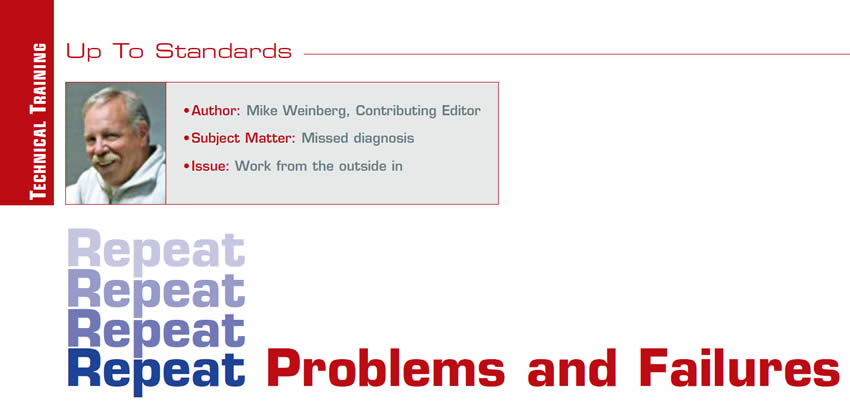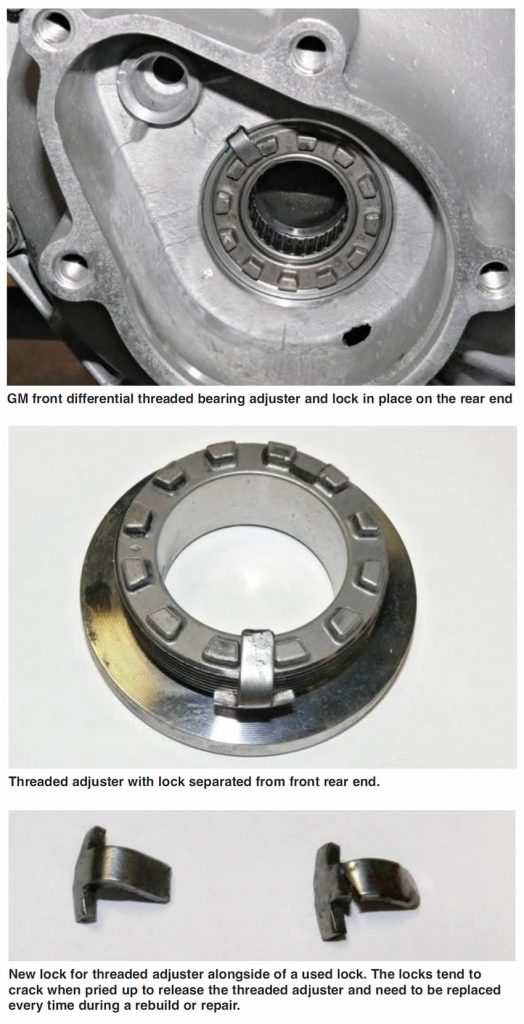
Up To Standards
- Author: Mike Weinberg
- Subject Matter: Missed diagnosis
- Issue: Work from the outside in
Gauging the traffic and the topics of calls we receive on our tech line make it obvious that many problems result from missed diagnostics and failure to view the issue as part of a complete vehicle system that must interact correctly. The simple truth in our daily routine is that the vehicles we service grow more complicated and complex by the day. Be careful of the quick “rush to judgment” when approaching any customer concern, as the urge to remove and inspect components internally in many cases focuses your attention on the “effect” instead of the cause.
I have preached for more years than I care to remember that the simple, practical and least waste of labor can only be obtained by working from the outside in. This means that your routine has to start outside of any internal component. Spend enough time with the customer to completely understand the problem that brought the vehicle to your shop.
Once you really know what the issues are, begin with a complete, THOROUGH inspection of the vehicle externally. Check battery voltage, trouble codes, tire sizes and pressures on all four wheels. Observe tire wear, physical wear, damage, water contamination, leaks, any newly replaced parts. Then try to duplicate the problem if the vehicle is drivable. Underhood and undercar inspections are now in order with particular attention to anything suspect in the driveline. Suspension, wheel-speed sensors, mounts, drive shafts, rear ends, brakes, and on and on until you have made notes regarding all vehicle situations. Now is the time to begin more internal inspection routines. Lubricant levels on all rotating parts, with careful attention paid to any debris that may show up on drain plugs, and fluid quantity and quality. Observations of noise, vibration and harshness will help guide you in a useful direction.
How many transfer cases and transmissions are removed only to find no internal damage, due to an incomplete vehicle inspection, where the problem turned out to be in a rear end or other driveline component? The following will focus on many common tech calls that are created by assumptions, which wind up devastating your wallet.


• GM trucks with 4L60, 4L65, or 4L70 automatic transmissions with 4WD: The vehicle comes in with a no-reverse condition. At least five shops a month will remove the transfer case for inspection. There is literally nothing in the transfer case that can cause a no-reverse condition – 99% of the time the problem will be in the transmission even though there may be no debris in the pan.
• A 2003 and up 246 transfer case comes in with an intermittent no-move condition. The driver selects the 4WD Auto mode and the truck moves and operates correctly until it happens again. This is another case where the transfer case gets torn down with no internal problems found. The fault is in the encoder motor, which will need to be replaced. On this transfer case the selector shaft has no detent. The driver selects a mode and the encoder motor engages the transfer case. When the motor sets the selector shaft in the desired location, an internal electric brake applies and maintains that mode until another is chosen. When the electric brake in the encoder fails, the selector lever is free to move out of position creating the no-move condition. How many T-cases do you think get opened up when the problem was outside in the encoder motor?
• A front differential GM 8.25 2WD/4WD with a passenger side axle leak after rebuild and hard to turn the axle. Model-year 2008 and up of this front diff uses a gasket between the housings. Using RTV instead of the gasket will move the axle tube closer to the carrier. The thrust washers in this diff are selective and there needs to be 30/1,000 endplay in the axle.
• Front differential GM 8.25 all-wheel drive 2008 and up. The carrier bearings have threaded adjusters to set the carrier properly (see photos). The threaded adjusters are retained by steel locks that are bent into the retaining slots in the adjuster. Never reuse these locks on a rebuild or repair as they fracture when bent back and forth several times. When the locks fail, the bearing will spin on the carrier boss, which makes the axle bore tight, and it is impossible to remove the passenger side long axle. The axle must be cut with a torch and replaced with new.
• Ford and Dodge 271/273 transfer cases break on the driver’s side. Rebuild the unit and replace the CV Joint in the front drive shaft. This failure is always predated by a slight vibration caused by the failing front drive shaft CV. When working on these, a very thorough inspection of the front prop shaft is a must to make sure that there is no potential for failure and destruction of the transfer case at road speed.
• The Jeep Wrangler is the icon of four-wheel drive. In 2007 Jeep built the four-door Wrangler, known as the “JK” designation, which was a huge marketing success, making more people Jeep owners. These vehicles have become much more sophisticated and complex, and in 2009 they added an electronic stability program and HAS, which stands for “hill start assist.” On a hill of 3 degrees or more (up or down), when the driver releases the brake to add power to engage the clutch, the brakes will hold the vehicle for 3 seconds and then release. This system has some sensitivity that not all drivers like. We have found a lot of drivability problems when the OEM clutch is replaced by an aftermarket model. The first problem is transmission noise generated by neutral-gear rollover caused by a difference in the damper springs on the disc from OEM to aftermarket. Due to the differences, engine harmonics are not damped enough and rattle the gear train in neutral. This does no harm to the gear train but makes the customer unhappy. The second issue arises from the aftermarket friction material being more aggressive than the OEM disc and stalls the vehicle when the HAS is applied. The third item that occurs is that certain aftermarket clutches will not release when the master and slave cylinder get hot. Allowed to cool down all is well until the heat cycle goes up and the slave cylinder fails to push the pressure plate diaphragm fingers deep enough for a proper release.
I am sure that I will hear from aftermarket clutch people about how good their products are, and they are great. However the HAS system is extremely sensitive with the OEM clutch and any minor differences magnify the problem. Every one of these problems was resolved by going back to an OEM Jeep clutch. If you have a customer who wants to put an aftermarket clutch in make them aware of the issues and get it in writing that this is what they want and the problems are on them. There is a procedure in the service manuals to turn off the HAS if the customer so desires.
These are all real world problems. If other people’s experience saves you some time and money, it was worth the trip.

Mike Weinberg is president of Rockland Standard Gear.













